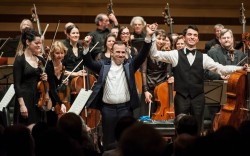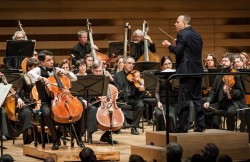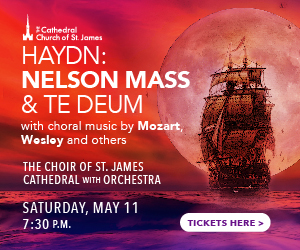 A highly charged, fully packed Koerner Hall audience greeted the appearance of Yannick Nézet-Séguin and his Montreal-based Orchestre Métropolitain for their Toronto debut April 24. In a brief introduction to the concert's first half, Nézet-Séguin spoke of his 15-year relationship with the orchestra and the “French colour” they would bring to the evening of English music he had programmed.
A highly charged, fully packed Koerner Hall audience greeted the appearance of Yannick Nézet-Séguin and his Montreal-based Orchestre Métropolitain for their Toronto debut April 24. In a brief introduction to the concert's first half, Nézet-Séguin spoke of his 15-year relationship with the orchestra and the “French colour” they would bring to the evening of English music he had programmed.
Elgar's Enigma Variations had an intensity that revealed the architectural solidity of the piece. Wonderfully balanced full chords proceeded via a series of crescendos. There was sentiment without sentimentality (swells were swell) and a jocularity that foreshadowed the Edwardian Age about to dawn. (The work was composed just at the end of the 19th century.) With each variation dedicated to a friend or loved one (the first lovingly portrays the composer's wife), Elgar's creation is filled with tenderness and nostalgia. Its pastoral qualities (for King and Countryside you might say) were epitomized by a wind choir supported by strings. The famous Variation IX, “Nimrod” was dedicated to the memory of Paul Desmarais, a great supporter of the orchestra. The slow build begun by the flute and oboe duet buttressed by low strings reached great and stately heights before suddenly disappearing into the air, like fluttering insects in the wind.
Nézet-Séguin brought out the many qualities of the music, from playfulness in VIII to the intense fellowship in XII (with its touching cello solo). It was uncommonly well-paced particularly in the leisurely moments. Yet, in a sign of what would come later, they didn't hold back in the last variation, Elgar's nod to himself.
It was impossible not to be aware of the intense communication between conductor and orchestra; the eye contact between them was unmistakable (as you can see in the photo below).
Twenty-year-old cellist Stéphane Tétreault, the soloist in Elgar's Cello Concerto, was the evening's revelation. The elegiac solo cello theme grew more forthright as it rose and broadened out in the full orchestra in classic romantic style. The slow movement shone with a chamber-music sensibility aided by the warm Koerner Hall acoustics; the finale's jaunty theme with its dynamic contrasts was well brought out. And the subtle moments of quiet beauty where the cello sings above everyone else were memorable for the colour and tone of the young soloist.
(Two days later, Tétreault won second prize in the Women's Musical Club of Toronto Career Development Award competition at Walter Hall. [I was told by a reliable source the audience seemed surprised he hadn't won.] The $10,000 will be welcome no doubt.)
In addition to the irony of a French orchestra coming to Toronto to play English music, the concert had a more concrete historical foundation. The Enigma Variations was composed at the height of the British Empire, the Cello Concerto just after the Great War. Vaughan Williams' Symphony No.4, written in the early 1930s, seemed to reflect the gathering storm that would burst into WWII. Nowhere was this more apparent than the intimations of Shostakovich in the second movement. These followed unsettled rumblings in the woodwinds that yearned for tentative resolution in the strings, all of which grew into a big brass choir before ending with a solo flute (marvellously played) that embodied uncertainty. The first movement, loud without being bombastic, evoked middle Europe while the third, which also didn't sound particularly English, was filled with eerie foreshadowings, slippery beauty in the strings. The Finale was a head-clearing blast of organized chaos that left no doubt of the skills of both conductor and orchestra.




